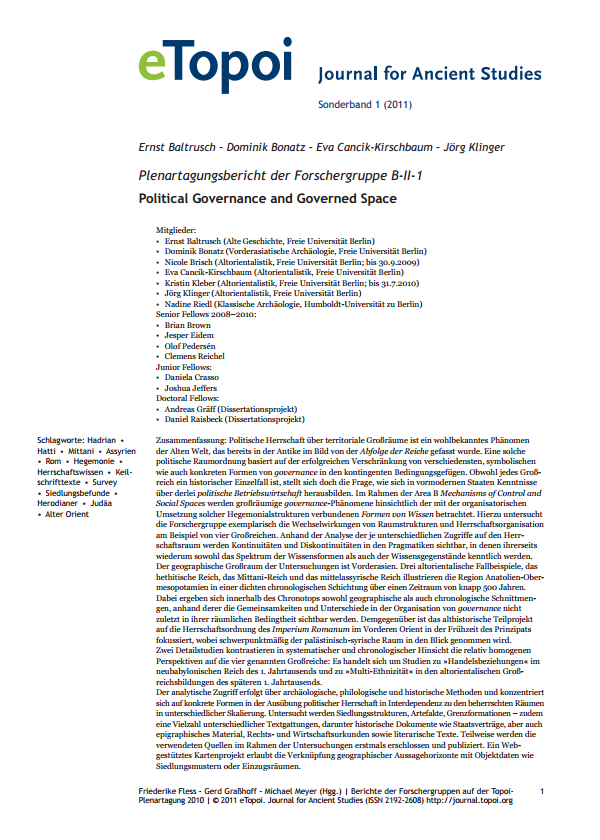Political Governance and Governed Space
Political authority over extensive territories is a well-known phenomenon of the ancient world, and one conceptualized already in antiquity through the image of the succession of empires. Each such politico-spatial order was based on the successful interrelationship of heterogeneous symbolic and concrete forms of governance in the context of contingent structural conditions. While each major empire must be regarded as a singular historical case, the question nonetheless presents itself of how an awareness of such structures of political administration were constituted in premodern states. In the framework of Area B Mechanisms of Control and Social Spaces large-scale phenomena of governance were examined particularly with regard to the forms of knowledge associated with the organizational implementation of these of hegemonic structures. This research group investigates the interdependency of spatial structures and the organization of authority with reference to four major empires. Brought to light through the analysis of contrasting interventions into these territories are continuities and discontinuities of practice within which the spectrum of forms of knowledge as well as the object of knowledge itself become discernible. The geographic region of investigation is the Near East. Three ancient Near Eastern case studies, namely the Hittite and Mittani Kingdoms and the Middle Assyrian Empire, illustrate the region of Anatolia-Upper Mesopotamia in a dense chronological stratification which traverses a period lasting circa 500 years. Emerging within this chronotope both geographically and chronologically are intersections through which commonalities and differences in the organization of governance are revealed, not least of all in their spatial conditionality. In contrast, the subproject in Ancient History dealing with the system of rule of the Imperium Romanum in the Ancient Near East focuses on the early period of the Principate, with a special focus on the Palestinian- Syrian realm. In terms of systematics and chronology, two detailed studies contrast the relatively homogeneous perspec- tives of the four above-named empires: the first examines “trade relations” in the Neo-Babylonian empire of the 1st millennium BCE, and the second “multiethnicity” in the formation of the ancient Near Eastern empires of the later 1st millennium BCE. The analysis proceeds via archaeological, philological, and historical methods and focuses on concrete forms of political authority as exercised in interdependency with the governed regions on various scales. Settlement structures, artifacts, and border formations have been investigated along with a multiplicity of textual genres, including historical documents such as treaties, but also epigraphic materials, legal, and commercial documents. Some of the sources are being made accessible and published for the first time in the framework of these investigations. A web-supported map project will permit links to be created between geographically defined discursive horizons and object data such as settlement patterns, areas of settlement, and texts.
Politische Herrschaft über territoriale Großräume ist ein wohlbekanntes Phänomen der Alten Welt, das bereits in der Antike im Bild von der Abfolge der Reiche gefasst wurde. Eine solche politische Raumordnung basiert auf der erfolgreichen Verschränkung von verschiedensten, symbolischen wie auch konkreten Formen von governance in den kontingenten Bedingungsgefügen. Obwohl jedes Großreich ein historischer Einzelfall ist, stellt sich doch die Frage, wie sich in vormodernen Staaten Kenntnisse über derlei politische Betriebswirtschaft herausbilden. Im Rahmen der Area B Mechanisms of Control and Social Spaces werden großräumige governance-Phänomene hinsichtlich der mit der organisatorischen Umsetzung solcher Hegemonialstrukturen verbundenen Formen von Wissen betrachtet. Hierzu untersucht die Forschergruppe exemplarisch die Wechselwirkungen von Raumstrukturen und Herrschaftsorganisation am Beispiel von vier Großreichen. Anhand der Analyse der je unterschiedlichen Zugriffe auf den Herrschaftsraum werden Kontinuitäten und Diskontinuitäten in den Pragmatiken sichtbar, in denen ihrerseits wiederum sowohl das Spektrum der Wissensformen als auch der Wissensgegenstände kenntlich werden. Der geographische Großraum der Untersuchungen ist Vorderasien. Drei altorientalische Fallbeispiele, das hethitische Reich, das Mittani-Reich und das mittelassyrische Reich illustrieren die Region Anatolien-Obermesopotamien in einer dichten chronologischen Schichtung über einen Zeitraum von knapp 500 Jahren. Dabei ergeben sich innerhalb des Chronotops sowohl geographische als auch chronologische Schnittmen- gen, anhand derer die Gemeinsamkeiten und Unterschiede in der Organisation von governance nicht zuletzt in ihrer räumlichen Bedingtheit sichtbar werden. Demgegenüber ist das althistorische Teilprojekt auf die Herrschaftsordnung des Imperium Romanum im Vorderen Orient in der Frühzeit des Prinzipats fokussiert, wobei schwerpunktmäßig der palästinisch-syrische Raum in den Blick genommen wird. Zwei Detailstudien kontrastieren in systematischer und chronologischer Hinsicht die relativ homogenen Perspektiven auf die vier genannten Großreiche: Es handelt sich um Studien zu “Handelsbeziehungen” im neubabylonischen Reich des 1. Jahrtausends und zu “Multi-Ethnizität” in den altorientalischen Großreichsbildungen des späteren 1. Jahrtausends. Der analytische Zugriff erfolgt über archäologische, philologische und historische Methoden und konzentriert sich auf konkrete Formen in der Ausübung politischer Herrschaft in Interdependenz zu den beherrschten Räumen in unterschiedlicher Skalierung. Untersucht werden Siedlungsstrukturen, Artefakte, Grenzformationen – zudem eine Vielzahl unterschiedlicher Textgattungen, darunter historische Dokumente wie Staatsverträge, aber auch epigraphisches Material, Rechts- und Wirtschaftsurkunden sowie literarische Texte. Teilweise werden die verwendeten Quellen im Rahmen der Untersuchungen erstmals erschlossen und publiziert. Ein Webgestütztes Kartenprojekt erlaubt die Verknüpfung geographischer Aussagehorizonte mit Objektdaten wie Siedlungsmustern oder Einzugsräumen.

